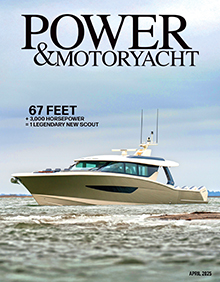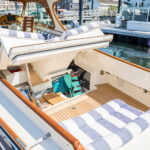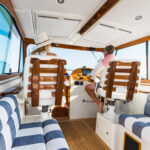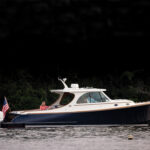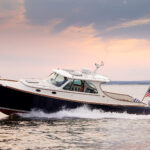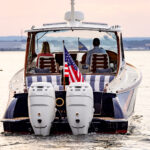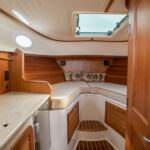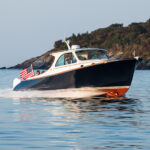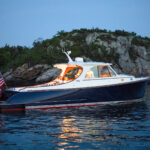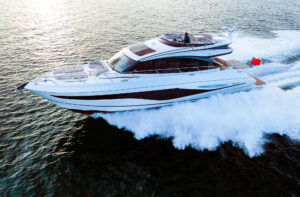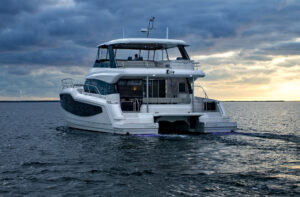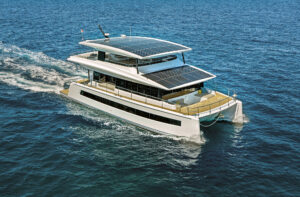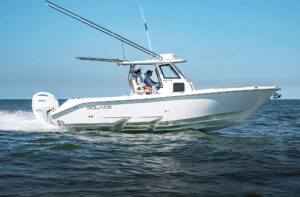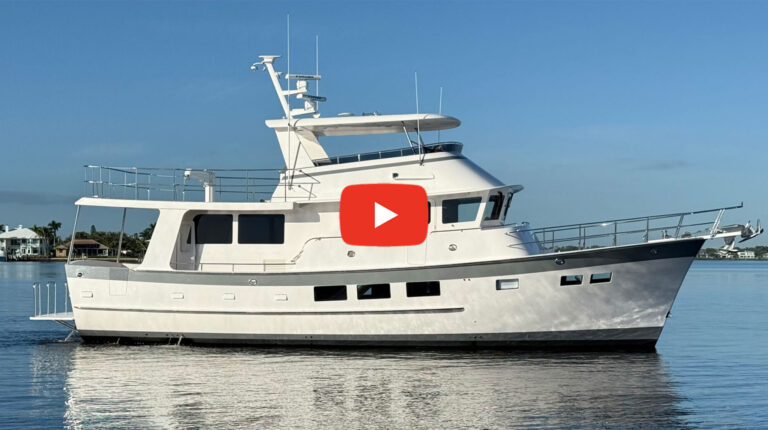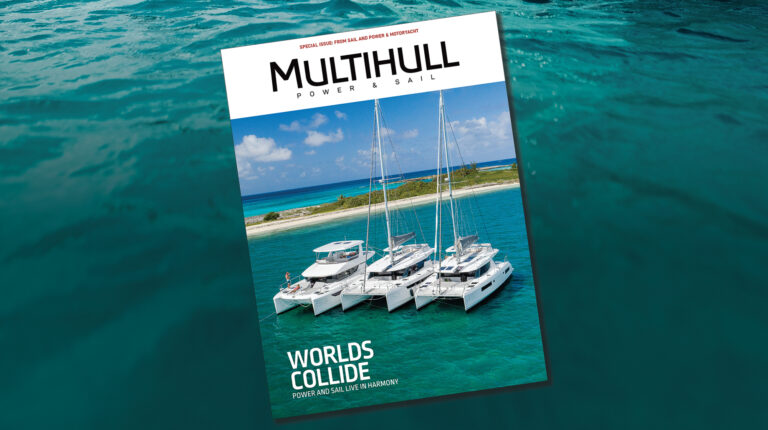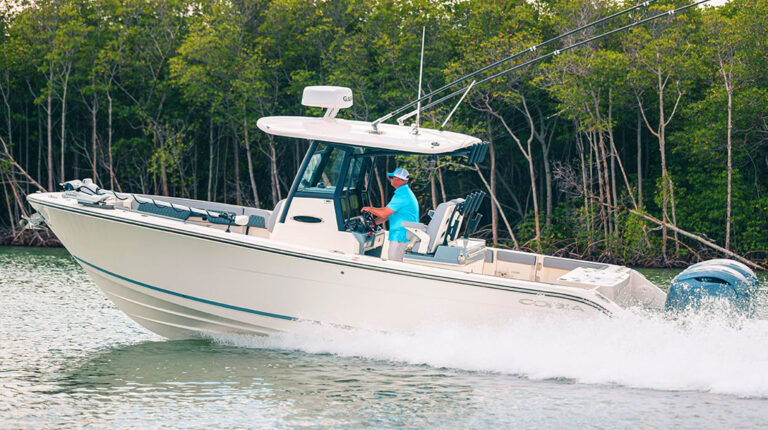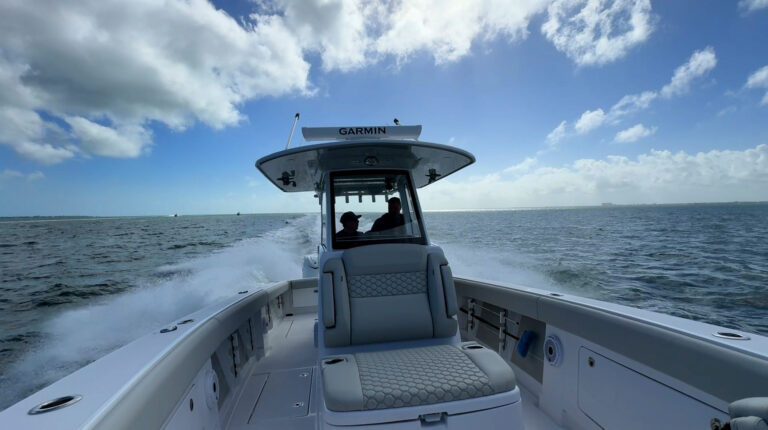The New Classic
Tradition and performance come together off Newport, Rhode Island, cruising onboard a new breed of Hinckley.

On a bad day behind the wheel of a car, Newport, Rhode Island, is the equivalent of the Alamo: crowded, disconcerting, with only a few ways in and seemingly no way out. That is partly due to the way the city was built. One-ways are abundant and labyrinthine. Beaux-Arts “cottages” squeeze out every last possible inch of manicured lawn before the land is swallowed up by the sea. On busy summer weekends, when sun dresses are de rigueur and icy cocktails are the best way to beat the heat, traffic snarls thanks to early city planners that never imagined a Ford F-350—or trolleys full of bachelorette parties—rolling down Thames Street. Then there’s parking. Stuck circling the ochre-red-brick jungle looking for a spot is a limbo better left for landlubbers, or the ones Henry David Thoreau quipped as “[thinking] more of the wine than the brine.”
It’s certainly no picnic.
If the above makes you crave a picnic, one need only look towards the water—quite literally, in the case of Hinckley, which operates one of the largest boatyards in the state in nearby Portsmouth. It’s there that the Down East builder puts the finishing touches on its classic, jet-powered Picnic Boats. (So classic-looking, in fact, that you would be forgiven for thinking the Picnic Boat’s recent anniversary was 50 years rather than a mere quarter century.) With lines a Gilded Age tycoon would envy, each one of the more than 1,000 built to date is a timeless, beautiful design made all the more practical by incorporating the seaworthiness inherent in a lobster vessel. The boats are primarily manufactured in Maine, but something about them just feels right deposited in Newport Harbor.

However, don’t expect to find any lobsters on the Hinckley 35, unless they’re on the half shell. And don’t call it a “Picnic Boat,” either. This new model is a standalone; a crowd favorite that has attracted both devotees and newcomers unfamiliar with or turned off by jet drives. Of the 13 owners who placed a deposit sight unseen, well over half have never owned a Hinckley. Still, when it comes down to brass tax, atavistically, everything you have come to expect from the brand is on display here. The biggest difference is [crooning George Harrison voice] something in the way she moves.
Driving into Newport, I didn’t have to worry about any of those unpleasantries mentioned earlier. My HQ for the next two days would be the recently built Brenton Hotel, located right off the waterfront in the spiritual heart of the city. The Brenton smartly offers a unique charter operation tailored to the city’s affluent past: its very own Hinckley 36. The hotel keeps the Brenton One tied up in the marina across the street, with captains ready to whisk guests away on private escapes and intimate sunset cruises around Narraganset Bay. Owing to this happy coincidence, we decided to “borrow” this one-of-a-kind experience—with plenty of hors d’oeuvres—and recreate it aboard Hinckley’s new outboard-powered model. In the business, this is what we call, with dead seriousness, a “two-fer.” Hey, it’s a tough job, but somebody’s got to do it.


After dropping my things off at the hotel, I strolled over to Forty 1° North marina to meet Scott Bryant, Hinckley’s VP of Sales and New Product Development. I found him in the 35’s dinette, standing beside a counter adorned with a bouquet of roses the color of orange sherbet. Bryant has overseen new product rollouts at the company for over 6 years: a tenure that includes Dasher, a prototype full-electric propulsion day-boat, to a line of performance-minded sport boats. Aka, the right guy to have along for a sea trial. The day before, Hinckley wrapped a photoshoot on both land and sea. This was partly in the interest of showing off the nearly 39-foot boat’s middeck storage compartment filled to the brim with electric scooters, an inflatable stand-up paddleboard and a fold-up table, with enough room for a Seakeeper and pump access.
My eyes, however, were on a different sort of prize. As a kid, my mother had drummed it into my skull not to ruin dinner with frivolous goodies, but the spread—twin 350-hp Mercury Verado engines—looked too good not to try. Dinner could wait. Putting the throttles down, it was time to dig in.
Southbound traffic was typical for a bluebird day in New England. Just ahead of us, an Everglades with triple outboards was chugging its way between a couple of schooners. On land, this kind of traffic would be a nightmare. This being the water, I patiently fell in line like a good little Boy Scout as we passed the sailboats, their rippling white sails unfurled to catch the afternoon breeze, before gunning the twin 350s to daylight. My inner speed demon smiled and nodded in approval.
Before we left, Bryant turned the Zipwake interceptors off so I could fully experience the Michael Peters-designed hull. Our Down East darling gradually climbed to 30 knots without ever feeling out of control or slamming into the choppy wave sets. It felt balanced and straight as an arrow thanks to wider chines and strakes that provide lift and stability. Up ahead was Castle Hill lighthouse, a stubby, two-toned member of its ilk, and Brenton Point State Park, which, like the hotel, is named in honor of a colonial governor. I took it all in thanks to what Hinckley calls the ClearView: a single-pane windshield that’s made its way (for the first time) from the sport boats to their white-glove offerings. We ducked into the long and narrow Mackerel Cove to take a closer look.
But wait. The flowers! Amazingly, they were still standing upright exactly where we had left them: on the dinette counter. Even after a series of hard-over turns, they hadn’t so much as budged an inch. I was skeptical. “They’re not pasted down!” laughed Bryant. Now that’s a neat party trick that will impress your friends.
On the 35, what I was most taken with was a series of contrasts. This two-dimensional day-boat outfitted with a forward scissor berth can handle rough seas, but it’s also easy on the eyes during a cruise around the harbor. It’s exquisite but seaworthy, a rough-hewn gem. And then there was the power. Of course, this isn’t the first Hinckley with outboards. Technically—technically—that honor goes to the Kingfisher 15, which Hinckley built in the 1950s in inboard and outboard configurations. But if we’re relegating that statement to the last 25 years, this new wave of outboard-powered boats starts with the 40c Sport Boat. The 35 is the closest they’ve come to bolting outboards onto a Picnic Boat.


Hinckley is well known for creating a signature series of Picnic Boats that lean into the brand’s classic, inimitable style. On board, the conversation shifted to what makes something “a classic.” Looks, yes, but to earn that hard-won benchmark, a product needs to be widely adopted physically and emotionally; it has to tug on the heart strings. If not, it has the propensity to fall into the cult-classic distinction. Or worse yet, the lemon basket. Is it possible that the 35 will one day be thought of like the Picnic Boats before it? “I think the market will tell us,” was Bryant’s restrained answer. “It could be.”
Hinckley devotees—or stewards, as they would rather be thought of—have no problem buying the newest Picnic Boat. But will they feel the same desire to own what amounts to a zag away from that history? Will hotels, from Newport to Timbuktu, line up to have the 35 as their charter boat?
I’ll leave that decision to, well, history. I’m certainly not here to convince you that outboards look right on a Hinckley. I am here to tell you that outboards make these boats go faster than their jet-driven counterparts, by as much as 10 knots, depending on the setup. (On the 35, twin 300-hp Yamaha or Mercury Verados come standard.) Granted, the acceleration isn’t like a sport boat, but then again, there’s no need for such bullish behavior. And though 40.1 is a couple knots shy of the posted top speed, it handled everything I threw at it.
Maybe that’s why you have owners flocking to this model from MJM, Grady-White and other brands. “All of a sudden we don’t have to train them and teach them about jets,” said Bryant. “They saw outboards and were like, ‘Okay, let’s do this.’” And while Hinckleys look completely at home in New England, Bryant says you can expect to see this 35 all over the country, from Florida to California and the Mid-Atlantic. Though its legacy is far from cemented, that certainly sounds like it’s off to a promising start.


From the Brenton’s second-story bar, with the white floor-to-celling drapes pulled back, it’s easy to spot the salt and its staples: the spars of the sailboats, the yachts, the gulls. On a clear day, you can even see all the way across the harbor to Fort Adams. The hotel calls this space the Living Room, and it feels like one, with convivial groups of sofas, leather arm chairs, tables, faux bleached coral lamps and brass fittings.
Still buzzing from the boat ride, I stopped by the lobby to check out before our sunset cruise. It’s hard to say what delighted me more: the locally sourced breakfast sandwich I had for brunch or the spacious bedroom with a king-sized bed and a do not disturb sign on the door handle that read “No Wake Zone” in big, bold letters. (What? I’m a sucker for boating puns.) Since this was a weekday, the bespectacled Managing Director Andy Ross informed me that the weekend spread is even better. Said Ross, “I run all week so I can go and eat that brunch. You’ll have to come back.”
Whichever way you slice it, I have a strange job. Globally recognized companies entrust their multimillion-dollar yachts to my care. These sea trials are usually done alone, sometimes with a photographer, sometimes with another editor, but, yeah, never with a chef. People in this industry are generally courteous with their time and vessels. But owing to the logistical nightmare it would cause—not to mention the liability of getting food all over the upholstery—a catered al fresco dinner with champagne flowing is typically not in the cards. But if you can swing it, why not wine and brine?
An added benefit was getting to take out Executive Chef Glaister Knight, the man behind the scenes. The soft-spoken Jamaican can usually be found provisioning the Brenton One day and night with his flair for adding unexpected ingredients to the local cuisine. He had yet to go out for a ride himself, so this cruise was long overdue. Growing up in Jamaica, the humble Knight learned how to cook at an early age from his mother. His career brought him to Newport, where he has taken up residence on and off for over 15 years, with stints at the Moorings Restaurant and the Clarke Cooke House.

Up at the helm, Bryant had gone from Hinckley VP to charismatic host. Knight had brought with him some of his signature lobster rolls, a bottle of Moët and a giant metal charcuterie board bedecked with various meats, cheeses and fruit. It was a meal fit for a swanky hotel guest—or an owner and their friends.
As the waterfront kept appearing on our starboard side, we happily circled the harbor, at one point passing a man on his stand-up paddleboard while his three young charges waved from the nose. The talk drifted from how hard it is to be a male chef in the machismo culture of Jamaica, to the similarities inherent in building boats and creating dishes people love, to the joy of cooking for others versus yourself.
The temptation was to sit back and enjoy the company and bites. But try as I might, I couldn’t help it: I wanted to switch seats with Bryant and take the 35 for one more spin. With the sun dipping its golden bands into the bay, that would be impossible. Still, everyone aboard effusively complimented the food and the experience. Said Bryant, “Everything tastes a little better on a Hinckley.” I have to say, I agree.
Afterward, as I was making my way off the dock, I was approached by an Oakleys-wearing gentleman surprised at what he was seeing. He asked what we were doing. I told him we had just finished testing the newest Hinckley. “Oh, that’s a Hinckley?” he asked while staring dubiously from his dark shades. “They make ‘em with outboards now?”
“They do,” I said.
I was about to call it the new classic, but I stopped myself. After all, that wasn’t my decision to make. It was up to him to decide.
Hinckley 35 Test Report

Hinckley 35 Specifications:
LOA: 38’8″
Beam: 11′
Draft: 2’10”
Displ.: 13,174 lbs.
Fuel: 300 gal.
Water: 35 gal.
Standard Power: 2/300-hp Yamaha or Mercury Verados
Optional Power: 2/350-hp Yamaha or Mercury Verados

